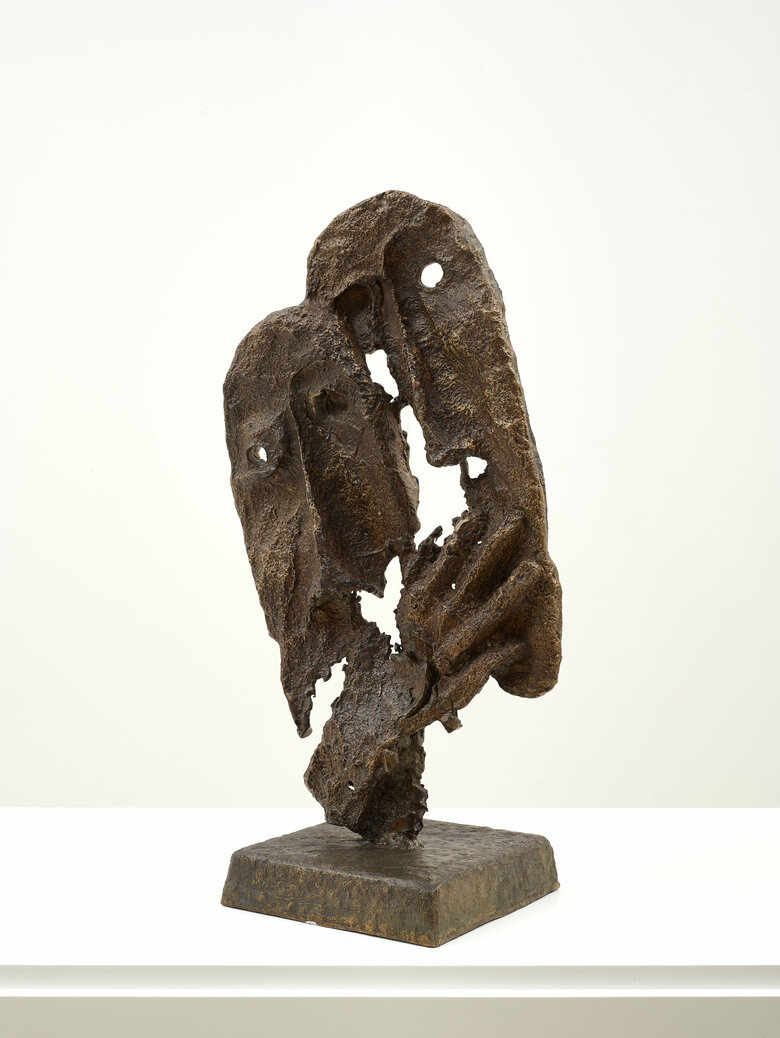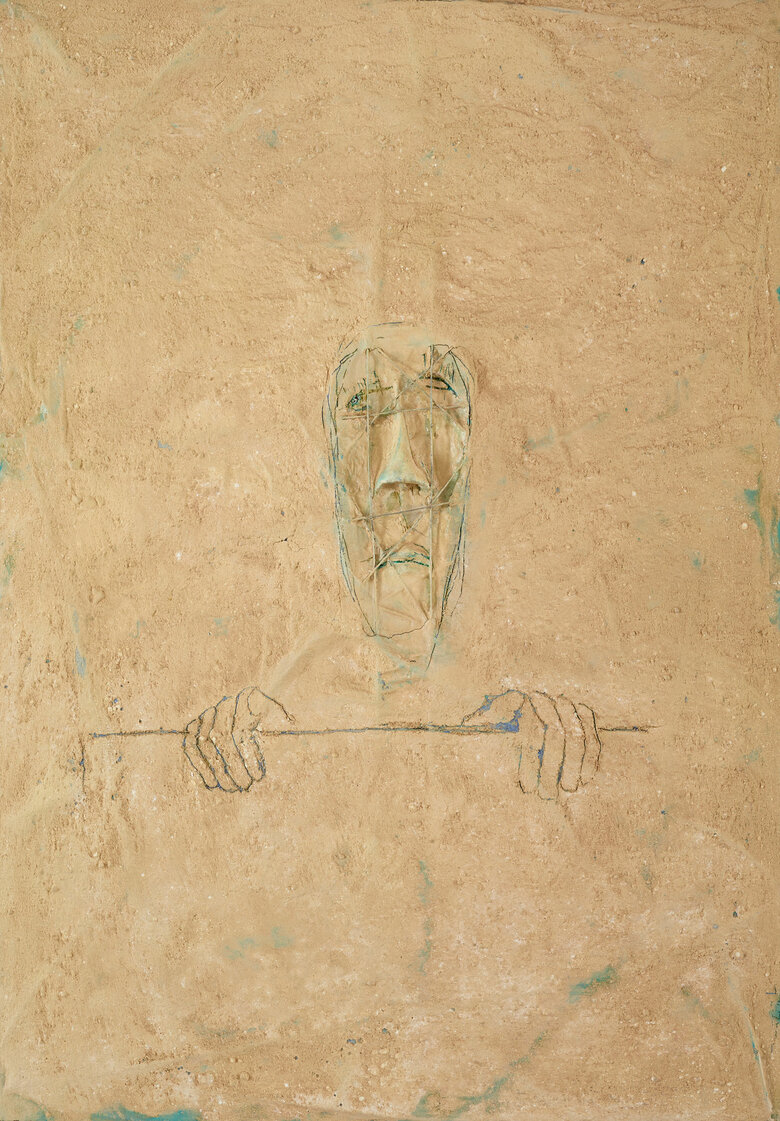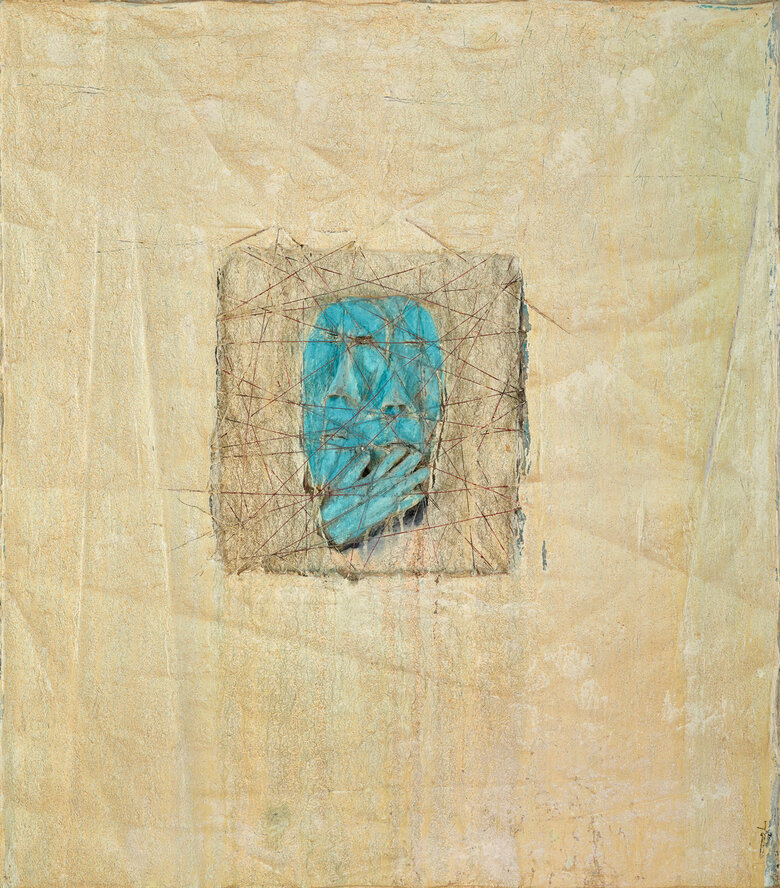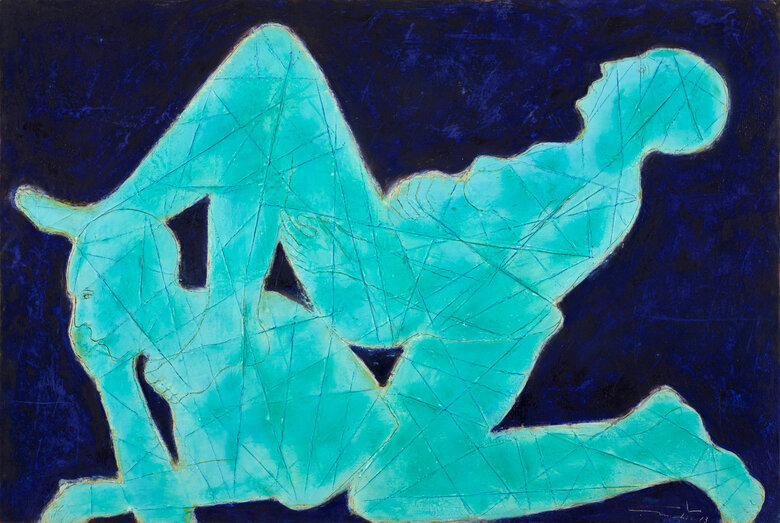Written by Arthur Debsi Born in 1959 in the old city of Marrakesh, in the neighborhood of Riad Zitoun, Mahi Binebine is the sixth of seven children from a modest, and well-educated family. Despite...
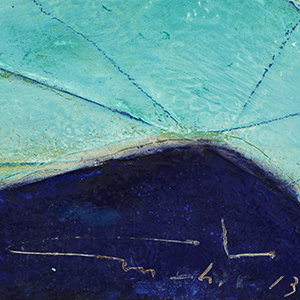

MAHI BINEBINE, Morocco (1959)
Bio
Written by Arthur Debsi
Born in 1959 in the old city of Marrakesh, in the neighborhood of Riad Zitoun, Mahi Binebine is the sixth of seven children from a modest, and well-educated family. Despite the absence of his father, an Arabic teacher with close ties to King Hassan II (1929-1999), and who had previously left the house; the young boy grew up in a very joyful environment, and was taught important human values. In July 1971, a military group failed overthrowing the monarchy, as a result of the attempt of the Skhirat coup d’état. In response to this putsch, King Hassan II (1929-1999) arrested, and judged every person involved in this operation, before ceasing them. Among these defendants, the older brother of Mahi Binebine, Aziz Binebine, who disappeared for twenty years, was eventually released from detention[1]. In 1980, Binebine traveled to France, and settled in Paris, where he studied mathematics, and then started a career as a teacher. Although he was from his country, he kept aware of the exactions conducted by the government of King Hassan II (1929-1999), by frequenting the Moroccan opposition circles based in the French capital city. Having taught mathematics for eight years, he dedicated his life to writing, as well as painting. In 1992, he wrote his first novel entitled Le Sommeil de l’Esclave, and has published one almost every two years since then. In his written work, he walks the reader through his childhood memories, questions humanity, and also tackles current subjects such as in Cannibales, published in 1999, in which he focused on the issue of illegal immigration from North Africa to Europe. After his lifetime in France, Mahi Binebine went to the United States, where he settled at his brother’s place in New York. However, he didn’t find himself comfortable living there, as he said: ‘All was easy, simple. And I missed France, Parisian life, my friends’[2]. He consequently went back to Europe, and started working between Paris, and Madrid, where he met, and collaborated with the Spanish artist Miguel Galanda (1951-). In 2002, witnessing the rise of the extreme right during the first round of the presidential elections, Binebine could not conceive France taking this political direction. Thus, he returned to Marrakesh, when the city’s development boomed.
The time spent in New York gave Mahi Binebine a wider visibility in the international artistic scene. In 1997, the artist held his first exhibition at the Stendhal gallery in the district of Soho, and the works caught the attention of the American patron Barbara Jonas (1933-2018). Through her, the Guggenheim Museum bought one of his works[3].
Mahi Binebine didn’t receive an education in art, and his painted oeuvre is not affiliated to any Moroccan, or international specific movements. He finds a correlation between his books, and his artistic production, which are both ways of expressing memories, torments, and melancholia. During the 1990s in New York, the art of Binebine reached a maturity point, through a vivid experimental process. The painter-writer demonstrated an evident interest in abstraction, and a technical talent by using a wide range of materials such as wax, blowtorch, nails, and pigments. Seeking for the luminosity, he applied a palette of bright colors such as red, ochre and blue, which somehow recall the colors of his hometown. Yet, Binebine preferred to use the color as a synthesis of his visual reminiscences of Marrakech, and not a realistic version of them. These colors cover the entire space of the canvas, and take the spectator into an intense dreamlike world. The painter progressively integrated human figures in his compositions, that he would paint in black, but didn’t chose to give any physical characteristic – sometimes, they are only silhouettes.
Since then on, the human figure has been at the heart of the oeuvre Mahi Binebine. He explores the self, and delves into the complexities, the deep desires, and the mysteries of the mankind. Through simple, and delicate drawing, he depicts naked bald men, and women, as if he brings them back to their primitive nature. Binebine uses the pure line, and cool colors, to illustrate these characters either alone, in couple, or in a group, who are completely detached from the physical reality. The figures adopt various positions, which corresponds to the different phases of the life being such as the tragedies, isolation, and glories. In the Dalloul Art Foundation’s collection, the artwork Untitled (2013) reveals two naked subjects, a man and a woman, painted in blue. The woman is confidently laying on the back of the man, who seems to be thinking. In the Moroccan modern painting, the representation of the body is quite recent, since the first movements were more turned towards the search of the Moroccan artistic identity, through the work on the local, and Islamic cultural heritage[4]. And alongside Mohammed Kacimi (1942-2003), Binebine is known for integrating the body as a pictorial element in visual arts in Morocco[5]. However, the artist’s conception of the body is not related to aesthetic, but more to material approach[6]. He envisages the body as a sculptural entity, which can take many forms. Here, he drew straight, and thin lines on the bodies of the characters, that he imagined to be fragmented, and also sensual. There is a sort of narrative aspect in the scene, where the artist creates a spiritual world, in which the individual becomes universal.
The impacts of the hazards of life are noticeable in a series of paintings, in which Mahi Binebine only illustrated human faces. The latter are hard, emaciated, and look like they are imprisoned by the lines, which scratched them, seen in the two examples present in the Dalloul Art Foundation’s collection. Both called Untitled, and executed in 2012, the paintings expose two faces, which occupy the middle of the compositions, and highly express grief, pain, and fate. Binebine intentionally separated them from the rest of the body in order to symbolize this inter worlds, in which he lives between Morocco, France, and the United States. These three geographical, and artistic dynamic areas, could present some tensions, as well as contradictions, that affected the painter. He aims to display this feeling of unease, and sorrow, that he perfectly renders in his sculpted oeuvre. Being an accomplished sculptor, Binebine likes to blur the boundary between painting, and sculpture. The faces strongly resemble African masks, like in Masque fragmenté (2014), also part of DAF’s collection. These two overlapped faces take a universal dimension, in the sense that the features are stereotyped; which makes their identities unknown. Although Mahi Binebine considers to embody African tradition[7], and this cultural affiliation is commonly assured, his choice goes beyond the affirmation of an African identity. He effectively works on the mask-like faces to reflect the unspeakable, and to free the unconscious. Like he does in his novels, Mahi Binebine succeeds in shedding light on the hard Human conditions living, and his solitude.
Mahi Binebine lives, and works in Marrakesh.
[1] Prolongeau-Wade, Souné. ‘Mahi Binebine: The Frontiers’ Smuggler’ in Binebine, Mahi, Prolongeau-Wade Souné, Frederic Charpentier, Touria Binebine, and Joachim Pissarro. Mahi Binebine. Casablanca, Morocco: Atelier k, 2007. [P.10]
[2] Mahi Binebine quoted in Prolongeau-Wade, Souné. ‘Mahi Binebine: The Frontiers’ Smuggler’ in Binebine, Mahi, Prolongeau-Wade Souné, Frederic Charpentier, Touria Binebine, and Joachim Pissarro. Mahi Binebine. Casablanca, Morocco: Atelier k, 2007. [P.11]
[3] Jeune Afrique. “Binebine, L'adieu Aux Larmes – Jeune Afrique,” June 10, 2009. https://www.jeuneafrique.com/202970/archives-thematique/binebine-l-adieu-aux-larmes/.
[4] Ali, Wijdan. Modern Islamic Art: Development and Continuity. Gainesville, USA: University Press of Florida, 1997. [P.75]
[5] Kabbal, Maati. ‘Le Corps et ses doubles’ in Binebine, Mahi. Mahi Binebine. Casablanca, Morocco: Les Éditions Art point, 2013. [P.259]
[6] Kabbal, Maati. ‘Le Corps et ses doubles’ in Binebine, Mahi. Mahi Binebine. Casablanca, Morocco: Les Éditions Art point, 2013. [P.259]
[7] Prolongeau-Wade, Souné. ‘Mahi Binebine: The Frontiers’ Smuggler’ in Binebine, Mahi, Prolongeau-Wade Souné, Frederic Charpentier, Touria Binebine, and Joachim Pissarro. Mahi Binebine. Casablanca, Morocco: Atelier k, 2007. [P.10]
Sources
Ali, Wijdan. Modern Islamic Art: Development and Continuity. Gainesville, USA: University Press of Florida, 1997.
Binebine, Mahi. Mahi Binebine. Casablanca, Morocco: Les Éditions Art point, 2013.
Binebine, Mahi, Prolongeau-Wade Souné, Frederic Charpentier, Touria Binebine, and Joachim Pissarro. Mahi Binebine. Casablanca, Morocco: Atelier k, 2007.
Binebine, Touria. Mahi Binebine [Exhibition catalogue, Mahi Binebine, March 2nd - April 30th 2014, Musée de La Palmeraie, Marrakesh]. Marrakesh, Morocco: Musée de La Palmeraie, 2014.
Jeune Afrique. “Binebine, L'adieu Aux Larmes – Jeune Afrique,” June 10, 2009. https://www.jeuneafrique.com/202970/archives-thematique/binebine-l-adieu-aux-larmes/.
Raji, Hicham. “L'univers Triste Et Passionnant De Mahi Binebine.” BAB, 2004. http://www.babelmed.net/letteratura/250-marocco/1152-l-univers-triste-et-passionnant-de-mahi-binebine.html.
Biographie Mahi Binebine: Marrakech: Peintre et Ecrivain. (n.d.). Retrieved August 31, 2020, from https://www.mahibinebine.com/biographie
“Biographie De Mahi Binebine,” January 11, 2014. http://atelier21.ma/fr/mahi-binebine-biography/.
Accessed September 1, 2020. https://www.claude-lemand.com/artiste/mahi-binebine?souspage=bio.
CV
Selected Solo exhibitions
2024
Mahi Binebine: On The Line, Sapar Contemporary, New York, USA
2022
Mahi Binebine: Pas de Deux, L’Atelier 21, Paris, France
2020
Horizons Obliques, Comptoire des Mines Gallery, Marrakech, Morocco
2019
A la plume, au pinceau, au crayon : dessins du monde arabe, Institut du monde arabe, Paris, France
2018
Indivision, with Hassan Darci, Art Space, Casablanca, Morocco
Solo exhibition, Galerie Noir sur Blanc, Marrakech, Morocco
Insoumission, Le Bastion de France, Porto-vecchio, Corsica, France
Claude & France Lemand Donation, Institut du monde arabe, Paris, France
2017
Aaart Fondation, Kitzbühel, Austria
Mémoire en mouvements, Galerie Abla Ababou, Rabat, Morocco
Galerie DX, Bordeaux, France
Retrospective, Galerie Claude Lemand, Paris, France
2016
MACMA museum, Marrakech, Morocco
2015
Insoumission, International Forum of human rights, Palmeraie Museum, Marrakech, Morocco
2014
Palmeraie Museum, Marrakech, Morocco
2013
Galerie Document 15, Paris, France
2012
Galerie 38, Casablanca, Morocco
Galerie Benamou, Paris, France
2011
Galerie Caprice Horn, Berlin, Germany
2010
Galerie Atelier 21, Casablanca, Morocco
AAART Foundation, Kitzbühel, Austria
2009
AAART Foundation, Kitzbühel, Austria
Galerie CMOOA, Rabat, Morocco
Galerie Delacroix, Tanger, Morocco
2008
Galerie Atelier21, Casablanca, Morocco
Galerie Violon Bleu, London, UK
Galerie Navarra-75 Faubourg, Paris, France
Galerie Loft, Paris, France
Galerie Bailly, Paris, France
2007
Société Générale Headquarters, Casablanca, Morocco
Galerie Nationale Bab Rouah, Rabat, Morocco
Galerie Noir sur blanc, Marrakech, Morocco
Palais des Congrès, Grasse, France
2006
Kasbah Agafay, Marrakech, Morocco
Galerie Venise Cadre, Casablanca, Morocco
Galerie Les Atlassides, Marrakech, Morocco
2005
Galerie Venise-Cadre, Casablanca, Morocco
Galerie Les Atlassides, Marrakech, Morocco
Silves Archeology Museum, Portugal
Silves Misericórdia Church, Silves, Portugal
Gemap, Casablanca, Morocco
2004
Galerie Atalante, Madrid, Spain
Galerie Brigitte Schenk, Köln, Germany
2003
Espace Actua, with Yamou, Casablanca, Morocco
Galerie Bab el kebir, with Selfati, Rabat, Morocco
Galerie AAM, Roma, Italy
Studio Bocchi, Roma, Italy
Fundacione Maturen, Tarazona, Italy
2002
Galerie Dahiez & Associés, Zurich, Switzerland
Galerie Brigitte Schenk, Köln, Germany
Museum of Marrakesh, Morocco
Société Générale, Casablanca, MoroccoInstitut Cervantes, Tanger, Morocco
Galerie Brigitte Schenk, Kunst Köln, Germany
Ministry of culture, Abu Dhabi, UAE
2001
Tinglado 4 Moll de Costa, Taragone
Palais des congrès, Grasse, France
2000
Espace Paul Ricard, Paris, France
1999
Galerie Nationale Bab Rouah, Rabat Stendhal, Gallery New York, USA
Galerie du Fleuve, Paris, France
Galerie Brigitte Shenk, Köln, Germany
1998
Ott Galerie, Düsseldorf, Germany
Museum of Contemporary Art, Washington D.C., USA
1997
Stendhal, Gallery New York, USA
1989
Contemporary French Art Gallery, New York, USA
1988
Galerie la Découverte, Rabat, Morocco
1987
Galerie de L'ONMT, Paris, France
Selected Group Exhibitions
2022
Maghreb – Works from North Africa – Morocco, Algeria, Tunisia, Libya, and Mauritania, Al markhiya Gallery, The Fire Station, Doha, Qatar
2021
Art, a serious game, MACAAL, Museum of African Contemporary Art Al Maaden, Marrakech, Morocco
2019
A la plume, au pinceau, au crayon : dessins du monde arabe, Institut du Monde arabe, Paris, France
2018
Carte blanche à Mahi Binebine, Galerie Katharina M. Raab, Berlin, Germany
Mare Nostrom, Comptoire des Mines Gallery, Marrakech, Morocco
2016
COP 22 Marrakech , Jardins des Arts, Morocco
With Najia Mehadji, Galerie DX, Bordeaux, France
2014
Dessine-moi un tapis, Comptoire des Mines Gallery, Marrakech, Morocco
2013
25 ans d’art contemporain Arabe, Institut du Monde Arabe, Paris, France
Galerie Albert Benamou, Paris, France
2012
Atelier 21, Casablanca, Morocco
Carte Blanche à MahiBinebine, Fondation CDG, Rabat, Morocco
Le corps découvert, Institut du Monde Arabe, Paris, France
Yemen National Museum, Sanaa, Yemen
Jordan National Gallery of Fine Arts, Amman, Jordan
La Sorbonne, Abu Dhabi, UAE
2011
Villa Emerige, Paris, France
2010
Galerie Ramp’Art, Marrakech, Morocco
Galerie Matisse, Marrakech, Morocco
Galerie Noir sur Blanc, Marrakech, Morocco
Galerie Arcane, Rabat, Morocco
2009
Galerie Matisse, Marrakech, Morocco
Galerie l’Atelier 21, Casablanca, Morocco
Fondation FAAP, Sao Paolo, Brazil
Violon Bleu gallery, Londres, UK
53rd Venise Biennale
2007
The State Central Museum of Contemporary History of Russia, Moscow, Russia
Societé Générale, Casablanca, Morocco
2005
Centre culturel français Rabat, Morocco
Galerie les Atlassides, Marrakech, Morocco
2004
Galerie les Atlassides, Marrakech, Morocco
Bogdan Korczowski, Mahi Binebine et Miguel Galanda, Theatre convention hall, Artemare Festival 2004, Bastia Corsica, France
2003
Société Générale Marocaine, Casablanca, Morocco
Marrakech museum, Morocco
Al Manar Gallery, Marrakech, Morocco
La teinturerie, Amien, France
2002
Institut du Monde Arabe, Paris, France
2001
Galerie Brigitte Schenk, Köln, Germany
Borj el Arabe, Dubaï, UAE
Espace Lasri, Paris, France
Grabadores Contemporaneos, Contratalia, Tarragone,
Galeria Acanto, Almeria, Spain
Puerto de las artes, Huelva, Spain
Centro de arte Casa Duro, Oviedo, Spain
Muséo de la cultura, Oviedo, Spain
2000
In Gallery Miami, USA
Musée du Château, Cagne-sur-mer, France
Espace Belleville, Paris, France
Institut du monde Arabe, Paris, France
Assilah Cultural Moussem, Morocco
1998
Raw, Stendhal Gallery, New York, USA
Galerie Brigitte Shenk, Köln, Germany
1997
Soireé of the senses, Stendhal Gallery, New York, USA
Grotesque, Stendhal Gallery, New York, USA
Publication by Mahi Binebine
Le sommeil de l’esclave, Editions Stock, Paris, 1992
Les funérailles du lait, Editions Stock, Paris, 1994
Cannibales, Editions Fayard, Paris, 1999
Terre d’ombre brûlée, Editions Fayard, Paris, 2004
Le griot Marrakech A, Edition de l’Aube, Paris, 2005
Les étoiles de Sidi Moumen, Editions Flammarion, Paris, 2010
Le Seigneur vous le rendra, Editions Fayard, Paris, 2015
Le fou du roi, Editions Stock, Paris, 2017
Rue du Pardon , Editions Stock, Paris, 2019
Awards
2020
2020 Mediterranean Award, Mediterranean Center for Literature, for his novel Rue du pardon (forgiveness street), Perpignan, France
2010
La Mamounia prize for his novel, Les étoiles de Sidi Moumen (Horses of God) Marrakech, Morocco
Collections
Kamel Lazaar Foundation, Tunis, Tunisia
Ramzi and Saeda Dalloul art Foundation, Beirut, Lebanon
Guggenheim Museum, New York, USA
Marrakech Museum, Morocco
Museum of Banque Al Maghrib, Morocco
Kinda Foundation, Saudi Arabia
Société Générale, Morocco
Attijariwafa Bank, Morocco
Crédit Agricole du Maroc, Morocco
CIH Maroc, Morocco
BMCE Bank, Morocco
Institut du Monde Arabe, Paris, France
Documents
Exposition Mare Nostrom
Olivier Rachet, Reda Zaireg, Soufiane Sbiti
Comptoire des Mines, French, 2018
Exhibition Catalog
Reviewed Work(s): Pollens by Mahi Binebine
Nathalie G. Cornelius
American Association of Teachers of French, The French Review, Vol. 77, No. 1 (Oct., 2003), pp. 188-189, English, 2003
Reviewed Work(s): Terre d'ombre brûlée by Mahi Binebine
Jonathan Smolin
Board of Regents of the University of Oklahoma, World Literature Today, Vol. 79, No. 3/4 (Sep. - Dec., 2005), p. 82, English, 2005
Reviewed Work(s): Cannibales by Mahi Binebine
Najib Redouane
American Association of Teachers of French, The French Review, Vol. 75, No. 1 (Oct., 2001), pp. 182-183, French, 2001
Reviewed Work(s): Les Etoiles de Sidi Moumen by Mahi Binebine
Claudia Esposito
American Association of Teachers of French, The French Review, Vol. 84, No. 5 (April 2011), pp. 1065-1066, English, 2011
Reviewed Work(s): Les funérailles du lait by Mahi Binebine
Melissa K. Marcus
Board of Regents of the University of Oklahoma, World Literature Today, Vol. 69, No. 3, Multiculturalism in Contemporary German Literature (Summer, 1995), p. 632, English, 1995
Reviewed Work(s): L'ombre du poète by Mahi Binebine
Melissa Marcus
Board of Regents of the University of Oklahoma, World Literature Today, Vol. 72, No. 4, Focus on Nuruddin Farah: The 1998 Neustadt Prize (Autumn, 1998), pp. 884-885, English, 1998
Mahi Binebine Al Manar
Éditions Al Manar Arts et littérature des pays du Sud méditerranéen, French
Mahi Binebine: Horses of God, chapter 16
Mahi Binebine- Translated to English by Lulu Norman
PWF 2014- Celebrating Morocco-Texts, Prague writers' Festival, English, 2014
Mahi Binebine: They clean them up
Omar Kholeif
PWF 2014- Celebrating Morocco-Texts, Prague writers' Festival, English, 2011
Press
L’univers triste et passionnant de Mahi Binebine
Hicham Raji
Babel Med, French, 2004
Binebine le fou du roi
Frederique Roussel
Liberation, French, 2017
Mahi Binebine, l’art de la fougue
Dounia Hadni
Liberation, French, 2019
ماحي بينبين يرسم صورته الخاصة عن المغرب في رسالة موجهة إلى أوروبا
Sharazad Al Alawi
Maghress, Arabic, 2011
ماحي بينبين: أخي خرج من معتقل تازمامارت وأنا ما زلت داخله
Mohammed ou Hrid
Maghress, Arabic, 2008
ماحي بينبين... فنان وروائي ذا6 صيته في العالم وخرج عن المألوف
Aziz Al Atatri
Maghress, Arabic, 2014
Moroccan writer and painter Mahi Binebine, winner of 2020 Mediterranean Award
Ya Biladi, English, 2020
الماحي بينبين يسرد سيرة والده في بلاط الملك
Mohammed Berrada
Al Hayat, Arabic, 2017
Mahi Binebine : Au nom de l’art, de l’humain et du fin esprit
Fadili Majda
La Tribune, French, 2019
Moroccan novelist Mahi Binebine's Horses of God explores the path to suicide bombings
Susannah Tarbush
The Tanjara, English, 2013
ماحي بينبين: أنا ابن عائلة شكسبيرية
Abdel Kabir Al Minawi
Asharq Al Awsat, Arabic, 2017
شعر في تشكيل: ماحي بينبين ويوسف وهبون
Al Araby al Jadeed, Arabic, 2016
Le double visage de Mahi Binebine
Florence Noiville
Le Monde, French, 2017
« Indivision », l’exposition de Mahi Binebine et Hassan Darsi à Casablanca
Lesco.ma, French, 2018
ArtSpace Casablanca inauguration with an unprecedented exhibition by Mahi Binebine & Hassan Darsi
Moroccan ladies, French, 2018
« Indivision »: le vernissage de Mahi Binebine et Hassan Darsi comme si vous y étiez
Pluriel.ma, French, 2018
Exposition « Dessine-moi un tapis »
Hicham Daoudi
Companie Marocaine des oeuvres et objets d'art, French, 2014
Exhibition Catalog
MAHI BINEBINE Artwork
Become a Member
Join us in our endless discovery of modern and contemporary Arab art
Become a Member
Get updates from DAF
Follow Artists
Save your favourite Artworks
Share your perspectives on Artworks
Be part of our community
It's Free!
We value your privacy
TermsCookiesPrivacy Policies
Become a Member
Get updates from DAF
Follow Artists
Save your favourite Artworks
Share your perspectives on Artworks
Be part of our community
It's Free!
We value your privacy
TermsCookiesPrivacy Policies
Become a Member
Get updates from DAF
Follow Artists
Save your favourite Artworks
Share your perspectives on Artworks
Be part of our community
It's Free!
We value your privacy
TermsCookiesPrivacy Policies
Welcome to the Dalloul Art Foundation
Thank you for joining our community
If you have entered your email to become a member of the Dalloul Art Foundation, please click the button below to confirm your email and agree to our Terms, Cookie & Privacy policies.
We value your privacy, see how
Become a Member
Get updates from DAF
Follow Artists
Save your favourite Artworks
Share your perspectives on Artworks
Be part of our community
It's Free!
We value your privacy
TermsCookiesPrivacy Policies

